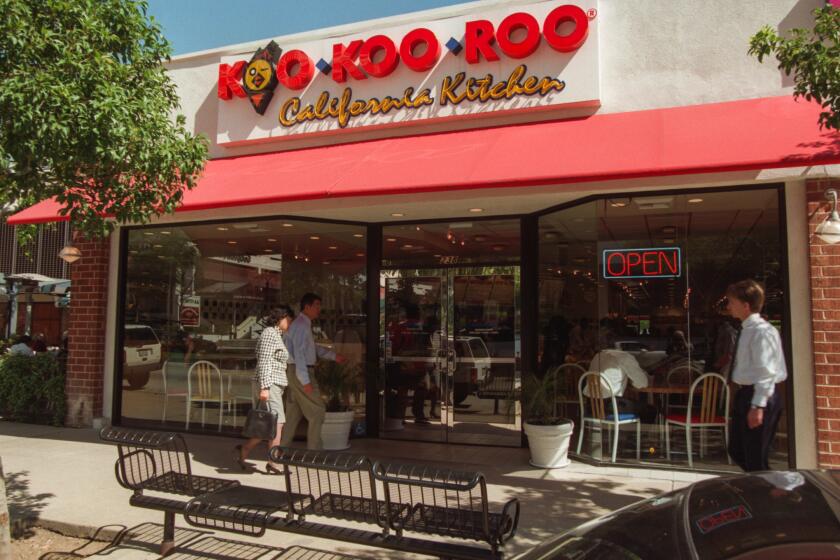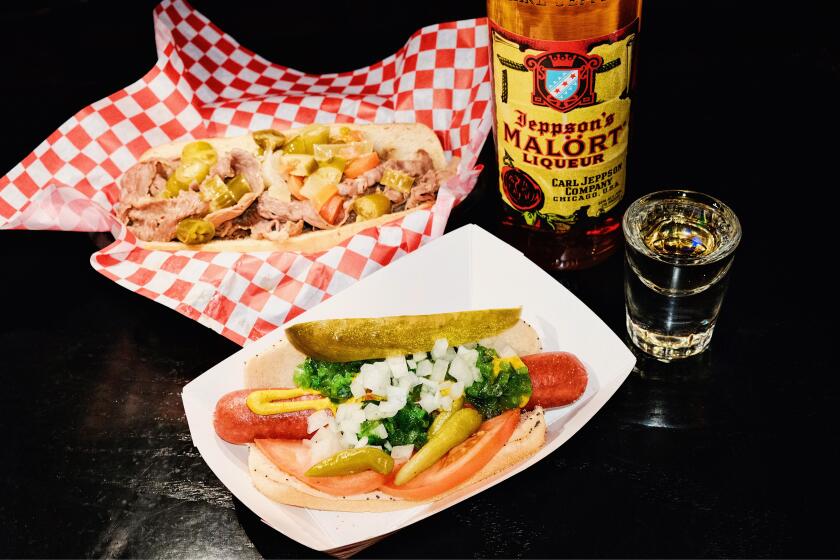I went to ChainFest for the nostalgia. What I saw was a crass glorification of trash food

- Share via
Hollywood’s upper-class elites have found a new way to show that they’re out of touch. And I fell for it.
Chain, a recent darling of social media and beneficiary of articles that speak of its nostalgia-fueled good times, promises the in-the-know somewhat exclusive access to the latest celebrity chef creations, specifically those from Tim Hollingsworth of the late, great Otium. The hook: The food is themed around dishes found in popular franchise-focused eateries, only this is fast food reimagined.
Chain is designed to rekindle memories in a way that excites your now-sophisticated taste buds. At past events, you could try an elevated Blooming Onion-inspired appetizer, a Wagyu beef-enchanced Taco Bell dish or a Pizza Hut-like pan pizza with 24-month aged Vacche Rosse Parmigiano — all with the help of a Michelin-starred chef.
At a Chain event, which has taken place in New York and L.A., and often at one-off pop-ups at its buzzy headquarters in Virgil Village, you enter a fantasy world where fast food is haute cuisine. The food of the common person — the meals scarfed down when everyone is too tired to cook, money is tight or the kids just need to be placated — is, in actuality, the food of the elite.
This week Koo Koo Roo, one of L.A.’s favorite bygone chains, announced its return. Here’s how it happened and when and how to get a taste.
To Chain, fast food is marketed as a uniter, a bridge between classes, as long as you sign up to receive a text message notifying you of its next not-so-secret event and rush to buy tickets. (And a Chain event isn’t cheap — I balked at a recent pizza night that topped $100.)
I was, I admit, drawn to Chain. I have fond memories of late nights working on the high school newspaper when we would debate who would make the McDonald’s run. Plus, I live within walking distance of Otium, a special-occasion place that I found many excuses to visit (does stress count as a special occasion?). And just as the first season of “The Bear” documented how one can build a better Italian beef, I trusted Chain to craft a superior hot dog.
Chain doesn’t know what it’s nostalgic for. Low quality food high in grease and fat? Companies that traffic in minimum wage jobs?
— Todd Martens
That’s why I bought a ticket to this past weekend’s ChainFest, Chain’s big-time festival. It was a bust, an uncomfortable gathering of trash food scattered among scorching-hot asphalt grounds. The event failed so drastically in its understanding of food culture that it essentially mocked the lower class. It’s the rich and their influencer pals cosplaying as commoners who eat fast food not because it’s the only restaurant available in their food desert of a neighborhood but because, hey, White Castle is good, actually. Surprise, it’s not.
This should have been a celebration for the company, which recently received a smattering of glowing press when the B.J. Novak-founded operation brought in Chrissy Teigen as an advisor. Chain also brags its association with the likes of Hollingsworth ensures only the highest quality food ingredients are used.
That wasn’t evident Saturday. Held at the Row DTLA, a retail and shopping complex in downtown Los Angeles, ChainFest was an embarrassment, a marketing charade masquerading as a nostalgia party. A sample text from a friend: “I should have eaten my money rather than this mediocre food.”

Agree that cash would have tasted better than literally anything to sample at ChainFest. I knew I had made a mistake as soon as I entered. It was clear I would not be getting the value of my $109 general admission ticket (VIP offerings topped $300).
The Chain Instagram had presented itself in a colorful, Disneyland-like map — a tiki drink over here, a fresh take on Domino’s pizza over there, an artsy interpretation of Panda Express up ahead and a resurrection of Koo Koo Roo in the VIP area — but what I was greeted with was chintzy off-the-shelf signs leading to food stands where uninterested workers juggled half-open cardboard boxes of food. It was cheap, crass and cruel, a place where food was treated as disposable. Just like at many of the eateries Chain champions.
And then there was this realization: Chain doesn’t know what it’s nostalgic for. Low-quality food high in grease and fat? Companies that traffic in minimum-wage jobs? It was fast-food firms, after all — some of which have been propped up at past Chain events — that spoke out against California’s Assembly Bill 1228, which sought to raise salaries for their barely surviving employees.
Chicago’s iconic Italian beef shop Mr. Beef is popping up in L.A. this weekend with ‘The Bear’ culinary producer Courtney Storer. Can’t make it? Here’s where to find great Italian beef, Chicago dogs, deep dish and tavern pies year-round.
Romanticism for fast food isn’t an anomaly ’round these parts. Southern California is arguably the birthplace of the modern chain restaurant — this is where McDonald’s got its start, after all — but what was once a cheap meal dedicated to a car-based, drive-thru culture has today become generally associated with poor ingredients, low wages, obesity and the sort of restaurants that populate low-income neighborhoods.
While I understand the appeal of an In-N-Out burger now and then, Chain seeks to cute-ify the sort of food that so much of the population relies on not by choice but out of necessity. Instead of using their resources for good — to, say, reimagine comfort food as something not just affordable but as inventive dishes made with fresh ingredients — Novak, Teigen and Hollingsworth at ChainFest instead opted to glorify the likes of Panda Express, Cracker Barrel, White Castle, Domino’s and more.
Perhaps they can do fast fashion or Big Oil next?
There’s been no shortage of big-name chefs attempting to tackle everyday foods. Our own city has been in the midst of a decade-plus-long pizza renaissance since Nancy Silverton launched Pizzeria Mozza. My favorite restaurant, Little Goat Diner in Chicago, is Stephanie Izard’s reinvention of the casual hangout spot, where a menu of chili crunch burgers, crab-enhanced cheesy dip, and peanut butter and bacon pancakes generally all falls under $20 per item. It’s also proof high-quality diner food can be done without cozying up to Johnny Rockets.
I expected a similar flair from ChainFest. What I got was an expo dedicated to small bites of chain-food staples. The White Castle slider was, for all intents and purposes, a White Castle slider. Sure, it came with a “Chain Castle Crave” sauce, but there was not much difference between this and the frozen White Castle burgers I ate in college. Except the latter didn’t come with a $100 entry fee.
While social media opinions on ChainFest were mixed, many, such as local digital creator Luis Marin, had a less-than-positive experience:
The mini waffles and chicken strips of Kentucky Fried Chicken was my next stop. This was a revival of an older recipe, we were told, but the chicken was a blob of blubber with the consistency of paper. Chain created multiple sauces to pair with them, but these little bombs of dryness needed more than a splash of dressing to become edible. I tried to wash it down with a $20 tropical rum drink that was Trader Vic’s branded, but it was all watered-down melted ice.
I did eagerly stop by Portillo’s. A Chicago native, I have admittedly fond memories of post-Little League hot dogs and Italian beef sandwiches, and have pilgrimaged to Buena Park to sample the SoCal outpost. But here? Forget it. A tiny dog littered with potato chips that obscured any taste and dominated the texture. A bite and a half and all I was left with was a bundle of relish.
Los Angeles has pizza galore, in any style you could ever want. We’re talking not only Neapolitan, New York, Detroit or Chicago ‘za. There’s that, and wilder.
I thought, too, of recent news reports surrounding fast-food companies and their workers — efforts by some food preparation staffers at Portillo’s to unionize, and a report last year, documented in The Times, which found that “current and recent fast-food workers ... make up 11% of all homeless workers in California.”
But that’s the core of the problem. No one involved, if Saturday is to be the judge, has shown a desire for critical thinking. Does Chain want to make a statement regarding the restaurants it heralds? And can it even do so while also marketing them, as it did in helping Panda Express launch a spicy chicken item?
As I pondered leaving Chain — there was a McDonald’s down the street and a Pane Bianco inside the Row, both of which were cheaper and would have offered better experiences, one upscale and one low — I put on my headphones and queued up Pulp’s anthemic song “Common People.” It’s a screed against the worst kind of rich, those who fetishize the working class to pander to them. “You think that poor is cool,” sneers Jarvis Cocker in the tune.

And ultimately ChainFest felt cynically opportunistic. There are, according to their official websites, around 20 outposts of Panda Express in L.A., and at least that many Domino’s within a short drive of my place.
So, then, why exactly does this company exist? The Chain team seemed outmatched at its signature event. Instead of reimagining Panda Express, we were reminded of why Panda Express is a last resort.
At a Chain event, you are buying more than a dish. You are buying a myth, albeit a tantalizing one, that the chain restaurants that are so ubiquitous across the country are actually good for us, the real heroes of the American food industry. As I looked down at the smoked salmon-topped slice of admittedly livened-up Domino’s pizza, I couldn’t help but wish it had a base more inviting than the franchise’s weighty mess of chewy dough. It all left me with a bad taste in my mouth.
More to Read
Sign up for The Wild
We’ll help you find the best places to hike, bike and run, as well as the perfect silent spots for meditation and yoga.
You may occasionally receive promotional content from the Los Angeles Times.










